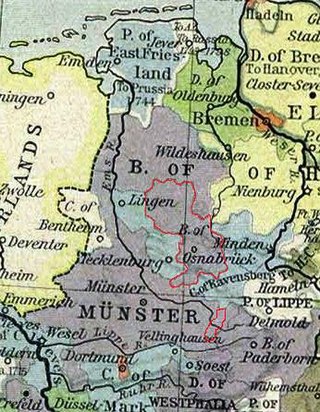Diepholz is a district in Lower Saxony, Germany. It is bounded by the districts of Verden, Nienburg, Minden-Lübbecke, Osnabrück, Vechta and Oldenburg, and by the cities of Delmenhorst and Bremen. The most populous municipality is Stuhr at the border to Bremen.
Nienburg is a district (Landkreis) in Lower Saxony, Germany. It is bounded by the districts of Diepholz, Verden, Heidekreis, Hanover and Schaumburg, and by the state of North Rhine-Westphalia.

The Principality of Calenberg was a dynastic division of the Welf Duchy of Brunswick-Lüneburg established in 1432. Calenberg was ruled by the House of Hanover from 1635 onwards; the princes received the ninth electoral dignity of the Holy Roman Empire in 1692. Their territory became the nucleus of the Electorate of Hanover, ruled in personal union with the Kingdom of Great Britain from 1714 onwards. The principality received its name from Calenberg Castle, a residence of the Brunswick dukes.
Hanover is a territory that was at various times a principality within the Holy Roman Empire, an Electorate within the same, an independent Kingdom, and a subordinate Province within the Kingdom of Prussia. The territory was named after its capital, the city of Hanover, which was the principal town of the region from 1636. In contemporary usage, the name is used only for the city. Most of the historical territory of Hanover forms the greater part of the German state of Lower Saxony but excludes certain areas.

Nienburg is a town and capital of the district Nienburg, in Lower Saxony, Germany.

The Province of Hanover was a province of the Kingdom of Prussia and the Free State of Prussia from 1868 to 1946.

The Prince-Bishopric of Osnabrück) was an ecclesiastical principality of the Holy Roman Empire from 1225 until 1803. It should not be confused with the Diocese of Osnabrück, which was larger and over which the prince-bishop exercised only the spiritual authority of an ordinary bishop. It was named after its capital, Osnabrück.
Albert II of Brunswick-Wolfenbüttel was Prince-Archbishop of Bremen in the years 1361–1395.
The Middle Weser Region includes, in its fullest sense, the land along the Middle Weser between Minden and Bremen. It lies within the federal states of North Rhine-Westphalia, Lower Saxony and Bremen. However, the term is often used just to refer to the Lower Saxon part, because of the different political development of the three states and the cooperative associations formed in Lower Saxony some years ago. The Lower Saxon part of the Middle Weser Region forms the geographical heart of this state. In the centre of the Middle Weser Region are the towns of Minden, Nienburg/Weser and Verden (Aller). In the extreme north, the city of Bremen, which is not part of Lower Saxony, has a very important influence on that area of Lower Saxony surrounding it.
Eric V of Hoya was from 1563 to 1575 Count of Hoya.
Count Jobst II of Hoya ruled the County of Hoya from 1511 until his death.
Otto VIII, Count of Hoya was the last ruling Count of Hoya.
Jobst I, Count of Hoya was the ruling Count of Upper Hoya from 1466 to 1503 and Count of Hoya from 1503 until his death.
Henry IV, Count of Waldeck was the ruling Count of Waldeck from 1305 to 1344. He was the second ruling count named "Henry", which is why some authors call him "Henry II". However, two earlier non-ruling members of the House of Waldeck are usually called Henry II and Henry III, and the subject of this article is commonly called Henry IV.
Albert II, Count of Hoya was the ruling Count of Hoya from 1545 until his death.
John V, Count of Hoya, nicknamed the Pugnacious, or the Wild, was the ruling Count of Hoya from 1426 until his death. He was the son of Count Eric I of Hoya and his wife Helen, the daughter of Duke Magnus II Torquatus. His brother Albert was Bishop of Minden. His brothers Eric and Otto were administrators of Münster and Bremen respectively.
Eric I, Count of Hoya (1370-1426) was a German nobleman. He was the ruling Count of Upper Hoya from 1377 until his death.
The County of Diepholz, that was first known as the Lordship of Diepholz, was a territory in the Holy Roman Empire in the Lower-Rhenish-Westphalian Circle. It was ruled by the Noble Lords, later Counts, of Diepholz from the late tenth century until 1585, when it was mostly incorporated into the Duchy of Brunswick-Lüneburg.








